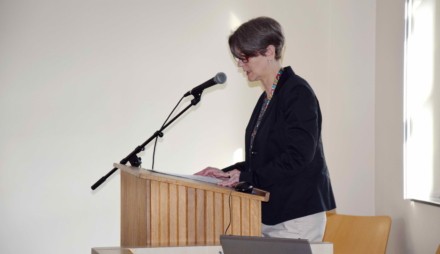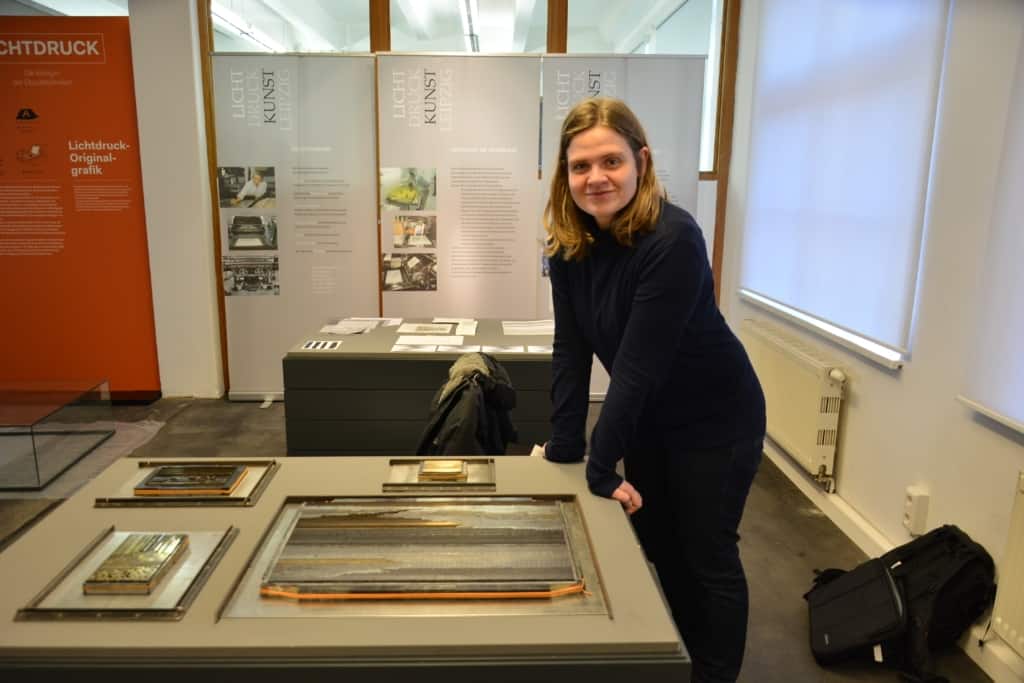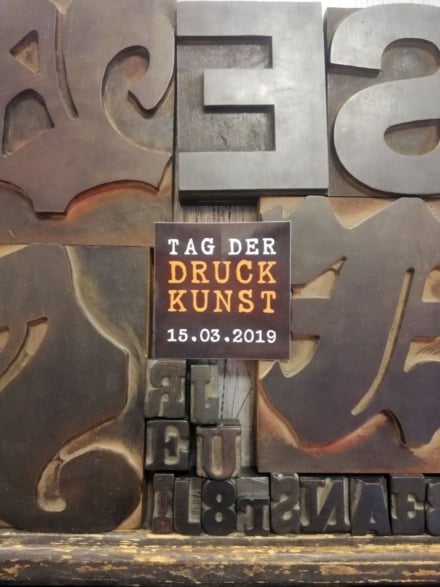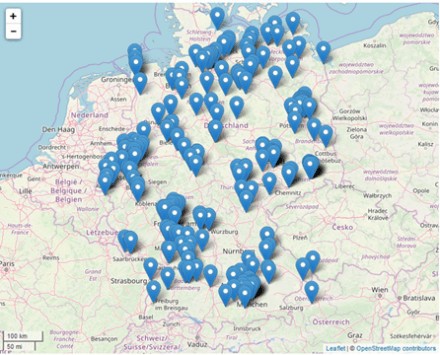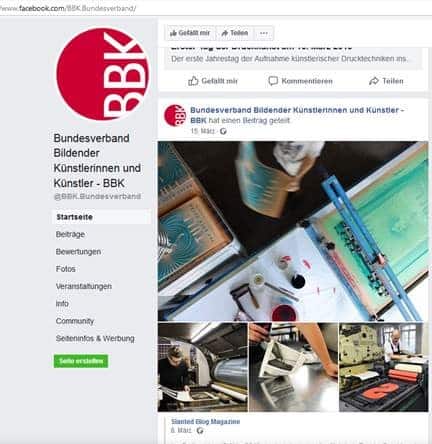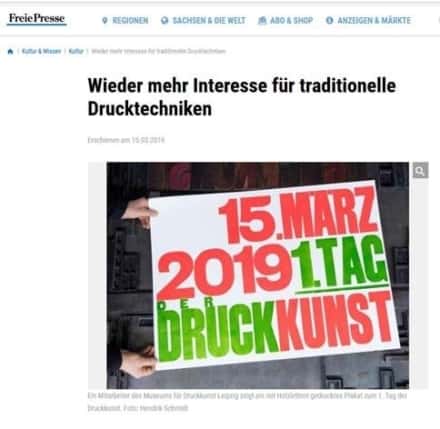Susanne Richter, Museum für Druckkunst, Leipzig, Germany
Talk given by Dr Susanne Richter, director of the Museum of the Printing Arts Leipzig/Museum für Druckkunst, Germany, at the conference of the Association of European Printing Museums, Safeguarding intangible heritage: passing on printing techniques to future generations, held at the Nationaal Museum van de Speelkaart, Turnhout, Belgium, 23-26 May 2019.
As museums and collectors in the graphic industry, we are all facing all the same problems: we have to keep the machines and devices in our collections working, preserve the knowledge of how to use them and try and make the general public aware of the history and ongoing relevance of printing techniques.
To use a picture: we are all sitting in the same boat, but throughout Europe we are paddling in different directions. Therefore it seems to me, that everyone has their own strategy to be successful and to survive. But in my opinion, the printing museums in Europe are currently focusing only on the problems at hand, and fail to see the opportunities we all have. This has to change fast, and I would like to show you one way of doing this together.
When I look at the participants of this conference, I can see mostly colleagues, who represent with their organizations the techniques of letterpress, fewer colleagues dealing with lithography, only very few standing for intaglio and copperplate printing, and fewer still who have collections with more than one technique. But where are the artists who are working with these techniques? They are not here. And that exactly is the problem – but at the same time part of the solution! We should first of all realize that without graphic artists this conference is representing only half of those active in the field, when we are talking about safeguarding the intangible heritage for the future.
You might say, this is an old problem that also exists or even starts in the colleges of art. You are either a student of art and learn about graphic techniques or you are a student of graphic design – and if you are lucky you learn about the basics of typography. But there is no fruitful interchange between the two branches – art and graphic design are still considered as two separate courses, but they have more things in common than usually seen by either professors or others.
Obviously it cannot be our aim to change the curricula of colleges of art in Europe today. But these young people are our most important target group for the future. They are beginning to show an interest in our subject and are increasingly fascinated by it. They belong to the group of the so called ‘digital natives’, they are under 30 and they were raised with digital devices and handle them expertly. But they start to feel that there is something missing in their ‘brave new world’. And that is precisely, where we have to get involved. These young people have a need for haptic experiences, for the analogue, they’ve had enough of clean designs and art works on flat screens and of creating works of art with these tools. As yet, there are only a few, but the group is growing. Look around you, there are so many trendy vintage-look stores, you see hand lettering on posters or at the bakery around the corner, we can see art with paper, mixed media with analogue and digital printed pictures. I want to show you one extraordinary example from Leipzig – the young artist Christina Wildgrube. She ‘painted’ and printed landscapes from lead types, decorative lead types. She assembled up to 10,000 types for one picture. Isn´t it amazing that a young woman took such great efforts to create a new work of art by using historic material that for her is a new tool and offers her new possibilities of artistic expression and new options for her search for grey scale values?
What I wanted to say and show to you, is that we all have to think out of the box, open our minds and our organizations to bring artistic printing and modern typography together!
This was successfully done on March 15, 2019, when the Berlin-based “Bundesverband Bildender Künstler” (the German Artists Association) called on all its members who are graphic artists, along with as museums, galleries and art institutes, to participate in the first national Day of the Printing Arts, organized on the first anniversary of the recognition of printing techniques as intangible heritage by the German Council of Unesco.
More than 250 participants all over Germany turned the event into a real success. For the first time ever, they all worked together and created an truly outstanding event. This event was organized via the internet and social media, only shortly before the event itself, flyers and posters were printed for advertising purposes. The German media took it on and covered it in print and online, both nationwide and at local level whenever participants talked to their local newspaper, for example. A few days before the event, the German ‘Bundesverband Bildender Künstler’ published a press release, interviews with some representatives and advertising material. But the best coverage came from online media. In my opinion this is no contradiction. We need the digital world to spread whatever we want to share. Whenever we post a video with a printing machine producing a ‘cool’ poster on our Facebook account, for instance, we get so many ‘likes’ and positive comments. I think you might have had similar experiences in your institutions. But this is only one example of how we can attract more people and create a lobby for printing techniques as intangible heritage.
Therefore I would like to propose that a European Day of the Printing Arts be organised next year. The 15th March 2020 is a Sunday, perfect for families and basically everyone to visit museums, printing workshops, studios and galleries.
Naturally, every country would have to organize this on their own for the German Bundesverband Bildender Künster cannot do this for you. In 2019 there were some participants in France and Belgium. But in 2020 there should be many more – all over Europe. So, please get into contact with your national or local arts commissions and present the idea to them. We’ve already proved that it works and can show the results and the success of the first initiative of this year.
Now it is your turn to contact politicians, opinion leaders, the media. In a way, you have to get on their nerves, irritate them, be a nuisance to get them involved. You have more in your hands than you think, there is the intangible printing heritage in Germany, there is the punchcutting heritage in France, our colleagues from the Imprimerie nationale are here, in Korea the Jijki is not only a festival, but World Printing Heritage. I was invited last year to Cheongju and was overwhelmed by the importance and relevance the local and national authorities attribute to their printing heritage and the attention payed to our delegation. I was also impressed by the money they spend on their world heritage and on bringing it to an international audience.
In Germany and Europe we still have a long way to go. My experience during the last year, however, has been, that finally people lend an ear when I talk about printing heritage. This is one of the positive results of the recognition of printing techniques as intangible heritage, and we now also receive more money for different projects to promote printing techniques. But according to the statutes of Unesc, such projects have be innovative, involve people and show how creative and alive our printing heritage is or can be.
And we are obliged to communicate all these efforts and projects on our websites, on Facebook, Instagram, we have to take pictures and share them with others, to raise their awareness and to make printing more visible. We have to share what we do, not only during conferences once a year, but more often in working groups, to learn from each other – for instance which projects work and which fail and why. There is even funding available from the EU for this purpose, Erasmus +, Strategic Partnership between three European Countries:
https://www.na–bibb.de/erasmus–berufsbildung/strategische–partnerschaften
Who is interested to join me and my team? I am looking for two more partners in two different countries to work together, to share ideas and to get the ball rolling.
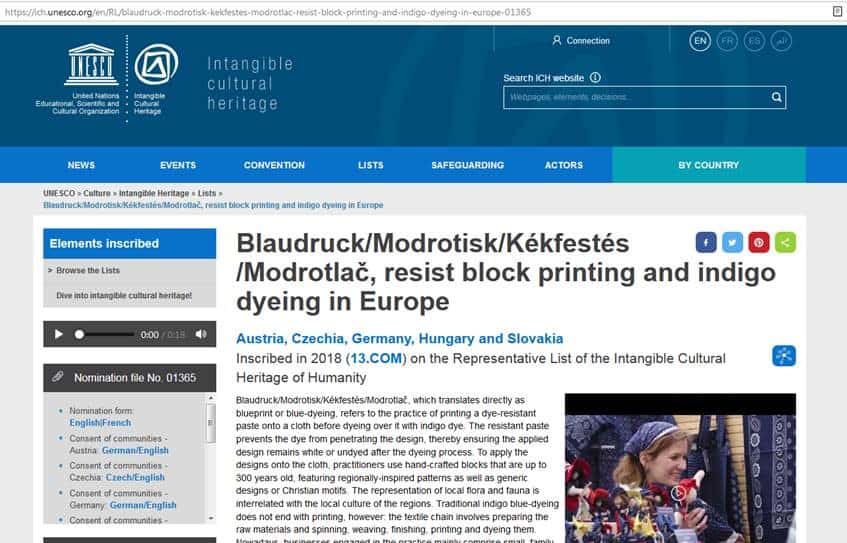
Our colleagues from Austria, Hungary, Czechia and Slovakia worked together in the field of Resist block printing and indigo dyeing in Europe. The outcome: last year, this was recognized as intangible heritage by Unesco. We should work together to try and bring printing techniques to an international scale. This involves work, a lot of work, but it is worth it! There have to be three countries, Germany and France already went through the national process of recognition, who will join us? Please think about it and contact me, if you’re interested! If we don’t take action, we will just keep complaining that the printing arts are not considered to be relevant in the digital world. Is this the future of our heritage?
But there is another international platform that printing museums have more or less neglected until now, namely industrial heritage. Only a few of us are listed at ERIH, the European Route of Industrial Heritage, but we all are part of a vivid industrial heritage in our countries. And industrial heritage is becoming more and more interesting for tourism in Europe. Keep this in mind and get into contact with your local or national tourism boards. This is another way of bringing art and printing technique together and to see how they can mutually benefit.
I hope I was able to show you how many opportunities and possibilities we have when we work closely together as European strategic partners for printing techniques, using all the channels the digital world offers us to promote and preserve this important intangible heritage, the analogue printing technique for the future – even in times of digitization.
Susanne Richter
